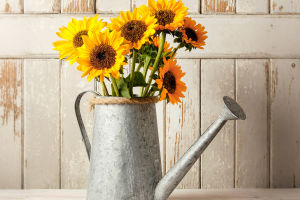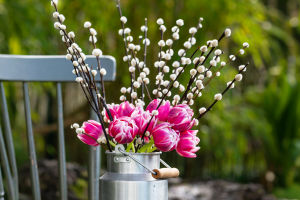Have you ever walked into a room and immediately felt a certain energy—peaceful, energized, or even romantic? It's not just the furniture or lighting; it's the flowers.
Flower design has been an essential element of interior décor for centuries. By carefully selecting and arranging flowers, designers can completely change the mood and ambiance of a space.
In this article, we'll explore how flower arrangements can influence the aesthetic and atmosphere of a room, and how different floral choices can evoke various emotions in those who experience them.
The Role of Flower Arrangements in Setting the Mood
Flowers are more than just decorative elements—they have a remarkable ability to affect our emotions. Whether it's a single vase of delicate lilies on a coffee table or a grand display of roses in an entryway, flowers have the power to set the tone for a room. The right flower arrangement can make a space feel warmer, more inviting, and even more luxurious.
For example, bright and bold flowers like sunflowers and tulips are perfect for creating an energetic, joyful atmosphere. They're ideal for living rooms or kitchens where you want people to feel relaxed and upbeat. On the other hand, softer flowers, create a serene and peaceful ambiance, making them great choices for bedrooms or bathrooms where calm and tranquility are key.
Choosing the Right Flowers for Different Spaces
Not all flowers are suited to every space. When selecting flowers for design, it's important to consider the space's function, size, and overall aesthetic. For instance, large, dramatic floral arrangements may overwhelm smaller spaces. In contrast, delicate flowers can get lost in a large room, so you may want to go for a bold statement piece in such areas.
For cozy living rooms or intimate dining spaces, consider flowers with rich colors like deep red roses, purple irises, or orange marigolds. These colors create a warm, inviting feeling and promote conversation and comfort. In contrast, light, airy flowers like daisies, lavender, or white lilies are more suited to creating open, airy, and fresh environments, perfect for spaces like kitchens, bathrooms, or sunrooms.
Another consideration is seasonality. Different seasons bring different types of flowers, and aligning your flower choices with the season can enhance the overall feel of a space. Spring is perfect for fresh tulips, daffodils, and cherry blossoms, while fall invites rich tones of chrysanthemums and asters. Seasonal flowers help create a sense of harmony with the time of year, making your space feel more connected to nature.
Flower Arrangement Styles: From Classic to Contemporary
Just as flowers themselves can evoke specific moods, the way they're arranged in a space can have a huge impact on the overall atmosphere. Traditional arrangements often feature a formal, symmetrical style, with flowers placed in a balanced, calculated way. These kinds of designs work well in more classic or formal settings, such as dining rooms, entryways, or spaces where you want to convey elegance and order.
In contrast, more modern, asymmetrical flower arrangements are often more fluid and dynamic. These arrangements use a more organic approach, allowing flowers to "flow" and create movement within the space. Such arrangements are ideal for contemporary, minimalist spaces, as they add an element of creativity and energy without overwhelming the design. This approach also works well in offices or creative spaces where inspiration and innovation are key.
Creating Focal Points with Floral Displays
Flowers are an excellent way to create focal points in a room. A well-placed floral arrangement can draw attention to a specific area, whether it's a centerpiece on a dining table, a statement piece on a console table, or an elaborate installation in the center of the room. Using flowers as focal points helps direct the flow of attention, guiding guests' eyes to the design elements you want to highlight.
For instance, a grand bouquet of lilies or roses at the center of a large dining table immediately draws attention, making the space feel more welcoming and luxurious. Similarly, flowers placed strategically in the corners of a room can create a sense of balance and symmetry, enhancing the overall visual appeal.
Flowers can also be used in creative ways to highlight architectural elements like windows, doors, or fireplaces. By placing a statement arrangement near these features, you can create a sense of harmony between nature and structure.
Flowers as Part of a Color Scheme
One of the most important ways flowers contribute to a space's aesthetic is through color. The color of flowers plays a significant role in how we perceive and experience a room. When selecting flowers, designers often consider the existing color palette of a room and choose flowers that either complement or contrast these tones.
For example, if a room has a neutral color scheme with tones of beige and white, adding a pop of color through vibrant flowers like red roses or yellow daisies can bring energy and liveliness to the space. Alternatively, if the room has bold, dramatic tones like navy blue or charcoal gray, flowers in softer, muted colors such as lavender or white can create a calming balance.
Flowers can also be used to tie together various elements in a room. For instance, if you have a piece of artwork with warm tones, incorporating flowers with similar hues can help connect the decor and create a cohesive visual flow throughout the space.
Seasonal Floral Arrangements for Constant Freshness
Another advantage of using flowers in design is their ability to change with the seasons. Just like fashion, floral trends shift throughout the year, and incorporating seasonal flowers into your design keeps the space feeling fresh and in tune with nature. In spring, tulips and daisies bring lightness and renewal, while autumn might bring the richness of sunflowers, mums, and dahlias.
Seasonal arrangements don't just reflect the time of year—they also create a sense of continuity and change. Changing out flowers regularly not only keeps your space visually interesting but also invites a deeper connection with the natural world around you.
Conclusion: Flowers as a Design Element
Flowers are far more than a simple decorative addition—they are powerful tools for shaping the atmosphere and aesthetic of a space. By understanding the role flowers play in interior design, we can use them to enhance moods, create focal points, and unify a room's design. Whether through soft, calming arrangements or bold, vibrant displays, flowers can turn any space into an experience.
Next time you walk into a room, pay attention to the flowers. How do they make you feel? How do they contribute to the overall design of the space? Flowers are more than just beauty—they are the silent storytellers of our environments.


